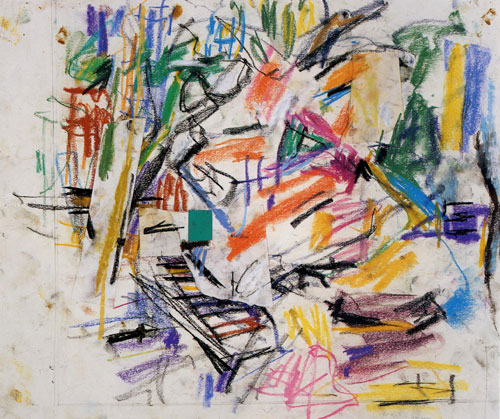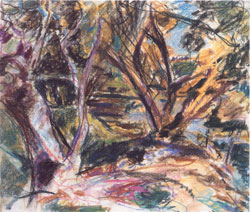SELECTED REVIEWS
Summer 2003 artcritical.com review
By GAEL MOONEY (reprinted with permission by author)
Louis Finkelstein: The Late Pastels, 1990-1999
Lori Bookstein Fine Art
June 17 to July 25, 2003

Pastel on paper, 14 x 16.75 inches
This and other images courtesy Lori Bookstein Fine Art
During the late afternoon when the sun begins to make its decline and the warm glow of daylight is overtaken by shadows, the world is bathed in an almost unnatural light. Cool shadows predominate while the light of setting sun singles out a rock, a tree or some other area for special scrutiny. Unlike the light associated with chiaroscuro that reveals mass and volume, the type of light to which I am referring achieves the opposite effect: It dissolves material distinctions both within and between existing forms, giving way to an overall transparency and brilliance similar to the light of a Gothic cathedral, or of a late Cézanne.
Being ephemeral by nature, such natural occurrences are not easily duplicated in painting. I was therefore astonished to walk into Lori Bookstein Fine Art one day to find that the light I had been laboring to capture while painting the park that afternoon had followed me into the gallery. Or, in any case, such was the powerful impression the exhibit of fifteen late pastels by Louis Finkelstein made on me when I first saw them.

pastel on paper with collage elements, 14 x 17 inches
Two stunning examples of what I am talking about can be seen in the pastels entitled respectively Bastion de Cézanne, II, and Aix-en-Provence — both of which were done during a trip the artist made to Cézanne territory in 1999. In Finkelstein’s Bastion — a depiction of the shed where Cézanne stored some of his paintings while working en plein air — a house located in the upper left-hand corner of the picture plane is situated behind a row of trees in the foreground that marks off the space into neat intervals. The house recedes into the background and would probably slip from view were it not for the fact that it is enveloped by an extraordinary light, causing it to dissolve into the sun and cerulean blue sky behind it. In Aix-en-Provence, a central pale pink tree shaped like a tuning fork divides the pastel in two and is stacked up against a mysterious violet pyramid shape (a rock perhaps) to give off a preternatural glow. The light, in both instances, transforms what would otherwise appear to be an ordinary scene into something far more miraculous and mysterious.
In Yellow Arbor, 1997, and Green Arbor, 1997, employing two different but equally vivid palettes, the artist applies vigorous strokes of color in an overall way to achieve a similar effect. However, unlike the calm tranquility of the pictures previously mentioned, the marks here create a centrifugal force that encircles the sloping diagonal and vertical lines of the arbor with the sweeping force of a tornado. And just in case there may be any doubt about the artist’s intentions, the notations in the left-hand margin of Green Arbor – ‘yellow pushes out and becomes matrix’, ‘blue violet under painting’ and ‘silver’ may provide some clues.
While the sensory experience was key to Finkelstein’s sensibility and is obviously what drove him, the influence of coming of age as an artist in the 1940’s and 1950’s in the environment of Abstract Expressionism is also clearly present in the fifteen works on view here. One example of this influence can be seen in the variety of ways the artist makes optimal use of the ground (or what he referred to as a ‘containing space’) as a formal means of expression in its own right. In Untitled (Cathedral Trees)1990, color is applied with loose and free strokes to evoke a feeling of weightlessness much like the interior of a Gothic cathedral (hence living up to its title). Similarly, in Vermont,1990, the artist applies delicate touches of color while allowing large areas of paper to show through so as to convey a vivid sense of atmosphere and light. In Figure in the Woods, 1998, fluid lines and broad organic shapes of color create an undulating tension between the figure and ground in a way that recalls de Kooning.

pastel on paper, 13.75 x 16.5 inches
In the excellent exhibition catalog which includes an informative essay by Martica Sawin, we are told that Finkelstein worked rapidly and directly from the motif. However, Finkelstein’s marks, (unlike those of his mentor, Cézanne) are notable for their inventiveness, not their consistency. Viewed at close range, they may come off as seeming impulsive or even haphazard. However, take a few steps backward and suddenly the space opens up, revealing a clarity and order that clearly shows that there is nothing arbitrary about what is going on here. Each mark, each color decision, represents a well orchestrated move — a mapping out of spatial relations responsive not only to the motif but also to the dictates of the picture plane and the harmony of the whole.
Notwithstanding the apparent speed with which the pastels may have been applied, Finkelstein’s marks are clearly the product of a careful kind of seeing (which Finkelstein viewed as a subject in its own right). The final result is works that instill in the viewer a similar kind of careful looking as that in which the artist himself was obviously engaged. Thus, as in Cézanne, in the end, it is not so much the quality of the mark but the quality of the investigation the mark signifies that makes a lasting impression.
GAEL MOONEY is an artist living in New York City